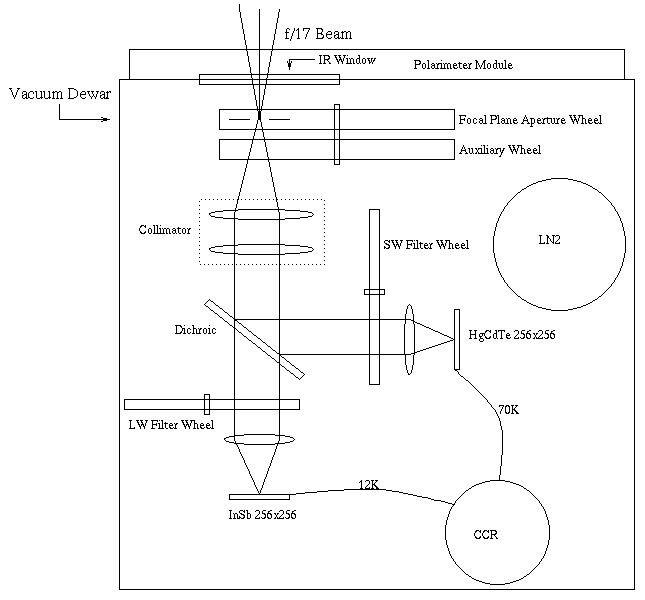What is Gemini?
Gemini is a multi-purpose, cryogenic, infrared astronomical imaging system for the wavelength range 1 to 5 microns (um). Its distinguishing feature is the use of an efficient dichroic beam-splitter to divide this large wavelength interval into two parts:
Short Wave (SW) from 1 - 2.4 um
Long Wave (LW) from 2 - 5 um
Two different infrared array detectors are used. The SW channel (also called Channel A or the "slow" channel) employs a NICMOS 3 HgCdTe array from Rockwell International with 256x256 pixels and the LW channel (Channel B or "fast" channel) contains an InSb array from SBRC, also with 256x256 pixels. Both detector arrays function independently and therefore two wavelength bands can be observed simultaneously.
When used at the Cassegrain focus of the University of California Observatories (UCO) 3-meter Shane telescope at Lick Observatory, Mt. Hamilton, the image scale is about 0.7 arcseconds per pixel and the total field of view is almost 3 x 3 arcminutes. With this field-of-view, and with twice the speed of other cameras, Gemini is well-suited for surveys and searches.
To isolate a given wavelength range, broad and narrow band interference filters are selectable by remote control in each channel. The focus of the telescope falls inside the vacuum enclosure where there is an "aperture" wheel with a cold occulting spot and a cold slit for infrared coronagraphic imaging and grism spectroscopy respectively. Grisms with R = 500 are provided for the J, H, and K bands at 1.2, 1.65 and 2.2 um. In addition, there is a Polarimeter Module with an externally-mounted (warm) JHK achromatic halfwave plate and a choice of internal (cold) polarizers (wire grid or calcite cube) for linear polarization measurements.
A general schematic of Gemini is shown below.

The average throughput is about 30% and the typical 3-sigma detection limit obtained in practice on the 3-meter telescope for a point source in 1 minute of integration is K' = 17.2, and simultaneously, J = 19.0.
Gemini is completely self-contained. The large vacuum enclosure, cryo-cooler and transputer-based electronics are all packaged together in a compact frame which, together with its telescope mounting flange, weighs about 500 lbs. A single cable connects the instrument at the telescope to the remote PC host computer located in the control room. The powerful "menu style" graphical user interface provides easy access to the numerous features of this instrument such as, automatic data file naming, FITS format storage, scripts for automated execution of repetitive tasks, instant image display of both channels and many useful "on-line" programs for quick-look reduction.
The instrument was designed and constructed at the UCLA Infrared Imaging Detector Lab between June 1991 and June 1993 with support from NSF grant AST90-18527.
Last modified: Thu Feb 15 15:50:21 PST 2007 by Elinor Gates